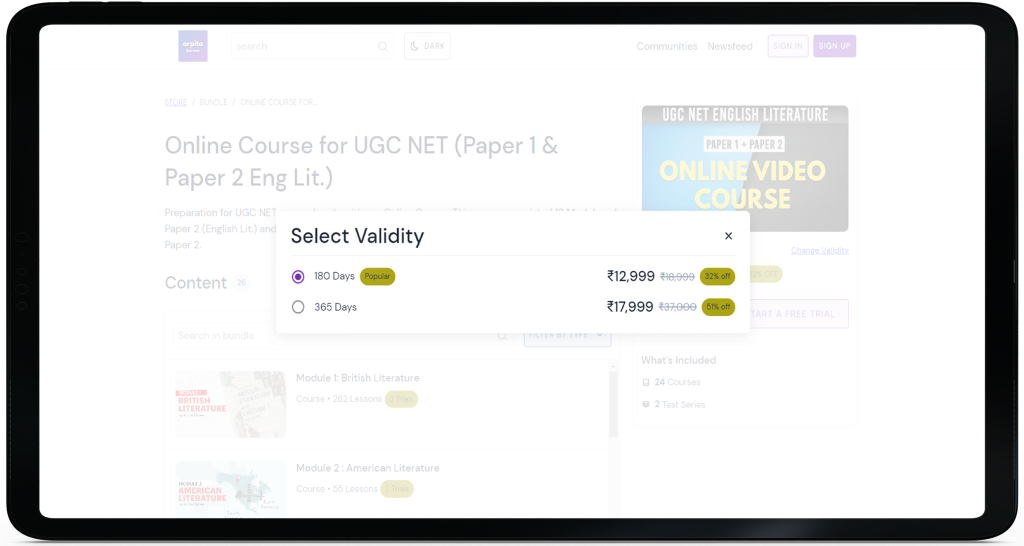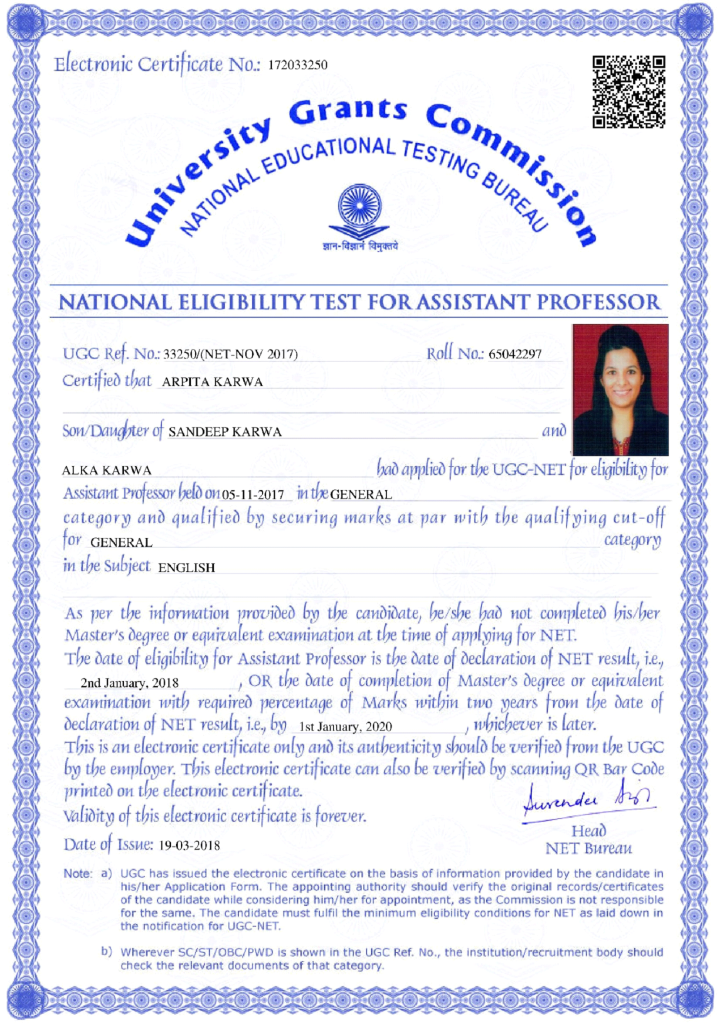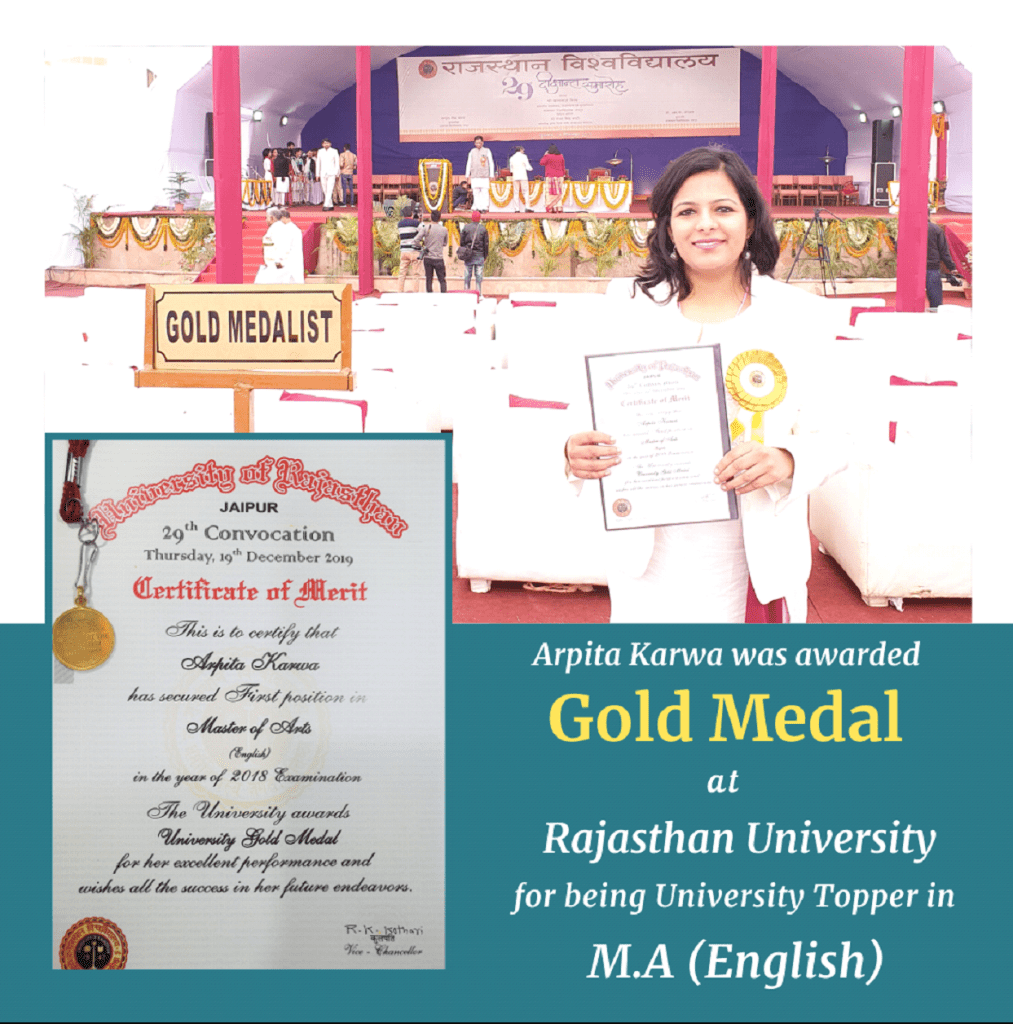June 2005 : Paper 2
October 18, 2022 2025-10-13 11:52June 2005 : Paper 2
June 2005 : Paper 2
1. The Nun’s Priest’s Tale had its origin in :
(A) The French Roman de Renart
(B) The Italian Boccaccios Teseide
(C) The English John Gower’s Confessio Amantis
(D) The Germal Goethe’s Faust
Answer: A
2. The First Folio of Shakespeare’s plays appeared in :
(A) 1664
(B) 1631
(C) 1623
(D) 1650
Answer: C
3. Restoration comedy begins with :
(A) Congreve
(B) Sheridan
(C) Dryden
(D) Etherege
Answer: D
4. The author of Of The Progress of the Soul is :
(A) John Bunyan
(B) John Donne
(C) Henry Vaughan
(D) Richard Crashaw
Answer: B
5. Dr. Johnson’s The Lives of The Poets is an example of :
(A) Psychological criticism
(B) Biographical criticism
(C) Historical criticism
(D) Archetypal criticism
Answer: B
6. The picaresque novel with a female picaroom is :
(A) Tom Jones
(B) Clarissa
(C) Moll Flanders
(D) Amelia
Answer: C
7. The expression “ancestral voices prophesying war” occurs in :
(A) ‘Kublakhan’
(B) ‘Frost at Midnight’
(C) Christabel
(D) Rime of The Ancient Mariner
Answer: A
8. The posthumously published novel of Jane Austen is :
(A) Sense and Sensibility
(B) Mansfield Park
(C) Emma
(D) Northanger Abbey
Answer: D
9. Carlyle’s Sartor Resartus means :
(A) Satan’s story retold
(B) The tailor retailored
(C) I know not where
(D) a set of elegant clothes
Answer: B
10. The character not created by Hardy is :
(A) Sue Bridehead
(B) Bathsheba Everdene
(C) Betsy Trotwood
(D) Thomasin
Answer: C
11. The poet who described poetry as “inspired mathematics” is :
(A) T.S. Eliot
(B) Hopkins
(C) Archibald Macheish
(D) Ezra Pound
Answer: D
12. The woman character who is an artist by profession in Virgnniia Woolf’s To The Lighthouse is :
(A) Lily Briscoe
(B) Mrs. Ramsay
(C) Mrs. Dalloway
(D) Miriam
Answer: A
13. The poet who said, “My poems are not about violence, but vitality,” is :
(A) Philip Larkin
(B) Ted Hughes
(C) C.D. Lewis
(D) Thom Gunn
Answer: B
14. Pinter’s Care Taker can be called a:
(A) comedy of manners
(B) comedy of menace
(C) comedy of errors
(D) comedy of humours
Answer: B
15. Toni Morrison used male narrator for the first time in :
(A) Song of Solomon
(B) Tar Baby
(C) Jazz
(D) The Bluest Eye
Answer: A
16. The author of The Hungry Tide is :
(A) Vikram Seth
(B) Shobha De
(C) Amitav Ghosh
(D) Upamanyu Chatterjee
Answer: C
17. The soul of tragedy, according to Aristotle is :
(A) Thought
(B) Character
(C) Plot
(D) Spectacle
Answer: C
18. The discussion of Fabula/Syuzhet occurs in :
(A) New criticism
(B) Deconstruction
(C) Structuralism
(D) Formalism
Answer: D
19. “United we stand, divided we fall” is an example of :
(A) Antithesis
(B) Bathos
(C) Tautology
(D) Litotes
Answer: A
20. A metre in which an unaccented syllable precedes the accented is called :
(A) anapaestic
(B) dactylic
(C) catalectic
(D) iambic
Answer: D
Choose the correct chronological sequence in question numbers 21-30 :
21. Choose the correct chronological sequence
(A) Northanger Abbey , Pride and Prejudice , Sense and Sensibility , Mansfield Park
(B) Mansfield Park , Sense and Sensibility , Northanger Abbey , Pride and Prejudice
(C) Pride and Prejudice , Northanger Abbey , Mansfield Park , Sense and Sensibility
(D) Sense and Sensibility , Pride and Prejudice , Mansfield Park , Northanger Abbey
Answer: D
22. Shakespeare criticism by :
(A) Spurgeon – T.S. Eliot -Stephen Greenblatt – Bradley
(B) Bradley – Spurgeon – T.S. Eliot – Stephen Greenblatt
(C) T.S. Eliot – Stephen Greenblatt – Bradley – Spurgeon
(D) Stephen Greenblatt – Bradley – T.S. Eliot – Spurgeon
Answer: B
23. Choose the correct chronological sequence
(A) Pre-Raphaelite Brotherhood, Oxford Movement, Movement Poetry, Imagism
(B) Oxford Movement, Pre-Raphaelite Brotherhood, Imagism, Movement Poetry
(C) Imagism, Movement Poetry, Pre-Raphaelite Brotherhood, Oxford Movement
(D) Movement Poetry, Pre-Raphaelite Brotherhood, Oxford Movement, Imagism
Answer: B
24. Choose the correct chronological sequence
(A) Closet drama, Epic Theatre, Theatre of the Absurd, Portable Theatre
(B)Epic Theatre, Portable Theatre, Theatre of the Absurd, Closest drama
(C)Portable Theatre, Closet drama, Epic Theatre, Theatre of the Absurd
(D)Theatre of the Absurd, Portable Theatre, Closet drama, Epic Theatre
Answer: A
25. Choose the correct chronological sequence
(A) Thomas Nashe, Ben Jonson, Kyd, Marlowe
(B)Ben Jonson, Thomas Kyd, Marlowe, Thomas Nashe
(C)Thomas Kyd, Marlowe, Thomas Nashe, Ben Jonson
(D)Marlowe, Thomas Nashe, Thomas Kyd, Ben Jonson
Answer: C
26. Choose the correct chronological sequence
(A) Essay on Dramatic Poesy , Areopagitica , Urn Burial , Religio Medici
(B)Areopagitica , Urn Burial , Religio Medici , Essay on Dramatic Poesy
(C)Religio Medici , Areopagitica , Urn Burial , Essay on Dramatic Poesy
(D)Urn Burial , Essay on Dramatic Poesy , Areopagitica , Religio Medici
Answer: C
27. Choose the correct chronological sequence
(A) Kamala Das, Sarojini Naidu, Toru Dutt, Meena Alexander
(B)Meena Alexander, Toru Dutt, Sarojini Naidu, Kamala Das
(C)Sarojini Naidu, Kamala Das, Meena Alexander, Toru Dutt
(D)Toru Dutt, Sarojini Naidu, Kamala Das, Meena Alexander
Answer: D
28. Choose the correct chronological sequence
(A) Jude, Lady Havisham, Dorothea, Mrs. Morel
(B)Dorothea, Mrs. Morel, Jude, Lady Havisham
(C)Dorothea, Jude, Mrs. Morel, Lady Havisham
(D)Lady Havisham, Dorothea, Jude, Mrs. Morel
Answer: D
29. Choose the correct chronological sequence
(A) The Well-Wrought Urn , The Verbal Icon , Theory of Literature , Literary Theory : An Introduction
(B)The Well-Wrought Urn , Theory of Literature , The Verbal Icon , Literary Theory : An Introduction
(C)The Verbal Icon , The Well-Wrought Urn , Literary Theory : An Introduction , Theory of Literature
(D)Literary Theory : An Introduction , The Well-Wrought Urn , Theory of Literature , The Verbal Icon
Answer: A
30. Nobel Prize Winners in Literature :
(A)Seamus Heaney, T.S. Eliot, Nadine Gordimer, W.B. Yeats
(B)W.B. Yeats, T.S. Eliot, Nadine Gordimer, Seamus Heaney
(C)T.S. Eliot, Seamus Heaney, W.B. Yeats, Nadine Gordimer
(D)Nadine Gordimer, Seamus Heaney, W.B. Yeats, T.S. Eliot,
Answer: B
Select the matching pair in question numbers 31 to 40 :
31. Select the matching pair
(A) A Idylls of the King – Browning
(B)The Diverting History of John Gilpin – William Cowper
(C)The Tower – T.S. Eliot
(D)The Fall of Hyperion – Shelley
Answer: B
32. Select the matching pair
(A) Hard Times – Psychological novel
(B)To The Light-house – Picaresque novel
(C)The Castle of Otranto – Gothic novel
(D)Wuthering Heights – Historical novel
Answer: C
33. Select the matching pair
(A) Emily Bronte – Yorkshire Moors
(B)Hardy – Scotland
(C)Walter Scott – Ireland
(D)Mark Twain – Yoknapatawfa
Answer: A
34. Select the matching pair
(A) Surrealism – Tristan Tzara
(B)Imagism – Spender
(C)Naturalism – Yeats
(D)Magic Realism – Galriel Garcia Marquez
Answer: D
35. Select the matching pair
(A) Victor Shklovsky – Carnivalesque
(B)Stanley Fish – Aphasia
(C)Hjelmslev – Glossematics
(D)Roland Barthes – Affective Stylistics
Answer: C
36. Select the matching pair
(A) Bessie Head – Newzealand
(B)Derek Walcott – South Africa
(C)A.D. Hope – Australia
(D)Ondaatje – Nigeria
Answer: C
37. Select the matching pair
(A) T.S. Eliot – The Birthday Party
(B)Osborne – The Entertainer
(C)Bernard Shaw – Luther
(D)Tom Stoppard – Lear
Answer: B
38. Select the matching pair
(A) Periodical Essays – Bacon
(B)Confessional Poetry – Ted Hughes
(C)Science Fiction – David Lodge
(D)Pre-Raphaelites – William Morris
Answer: D
39. Select the matching pair
(A) Nissim Ezekiel – Persian
(B)Gieve Patel – Gujarati
(C)Dilip Chitre – Sanskrit
(D)Adil Jussawallah – Urdu
Answer: B
40. Select the matching pair
(A) Pearl- The Scarlet Letter
(B) Raka- The God of Small Things
(C) Raphael- The Great Expectations
(D)Pip- Fire on the Mountain
Answer: A
41. The assertion, “We had a very restful holiday,” implies :
(A) We didn’t exert ourselves
(B) We did nothing
(C) We were very lazy
(D) We had a very dull time
Answer: A
42. “The progress of an artist is an continual self sacrifice, a continual extinction of personality. “This assertion implies :
(A) Merely by a continual extinction of personality an artist is sure to make progress
(B) An artist is likely to make progress through continual self sacrifice and extinction of personality
(C) Continual self sacrifice and extinction of personality will undermine the progress of the artist
(D) An artist must have a personality to create art
Answer: b
43. “The best poetry will be found to have a power of forming, sustaining and delighting us”. This assertion implies :
(A)Poetry has multiple functions to perform
(B)Poetry is more useful than other arts
(C)All other arts including poetry have their limitations
(D)Poetry has no role to play
Answer: b
44. “Human beings, and especially human beings as an integral part of a social organisation are regarded as primary subject matter of literature”. This assertion implies :
(A)Human beings alone can be the subject matter of literature
(B)All living beings-animal and human, contribute towards the creation of literature
(C)Humans as social beings are the nucleus of all literary exercise
(D)Literature transcends the human and the non-human.
Answer: c
45. “We must learn to see more, to hear more, to feel more”. The assertion implies :
(A)Human beings have only three faculties at their command to comprehend all knowledge
(B)A sharpening of three faculties mentioned would help human beings to become better
(C)Only with the combination of all senses, we may become better
(D)Seeing, hearing and feeling are not enough to become better human beings
Answer: B
Read the passage below, and answer the questions that follow based on your understanding of the passage :
John Dryden in the late seventeenth century defined poetic license as “The liberty which poets have assumed to themselves, in all ages, of speaking things in verse which are beyond the severity of prose”. In its most common use the term is confined to diction alone, to justify the poet’s departure from the rules and conventions of standard spoken and written prose in matters such as syntax, word order, the use of archaic or newly coined words, and the conventional use of eye-rhymes. The degree and kinds of linguistic freedom assumed by poets have varied according to the conventions of each age, but in every case the justification of the freedom lies in the success of the effect.
In a broader sense, “Poetic License” is applied not only to language, but to all the ways in which poets and other literacy authors are held to be free to violate, for special effects, the ordinary norms not only of common discourse but also of literal and historical truth, including the devices of metre and rhyme, the recourse to literary conventions, and the representation of fictional characters and events.
46. ‘Poetic license’ means :
(A) liberty with diction, alone
(B) liberty with diction and norms of common discourse
(C) liberty with historical truth
(D) liberty with representations of fictional characters
Answer: A
47. ‘Linguistic freedom’ is :
(A) freedom with diction, newly-coined words, syntax
(B) freedom with the use of colloquial language
(C) freedom with the use of figurative construction
(D) freedom with literal truth
Answer: A
48. How do you justify the linguistic freedom taken ?
(A) on the basis of scholarship embedded
(B) on the basis of form
(C) on the basis of the success of the effect
(D) on the basis of the thematic grandeur
Answer: C
49. “Diction” means :
(A) severity of prose
(B) devices of metre and rhyme
(C) poetic license
(D) syntax and word order
Answer: D
50. “Poetic license” applies to :
(A) Poets alone
(B) All literary
(C) Dramatists only
(D) Epic writers only
Answer: B
















